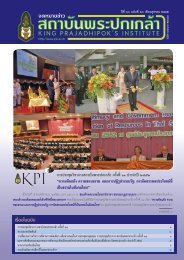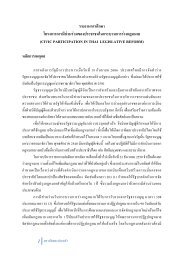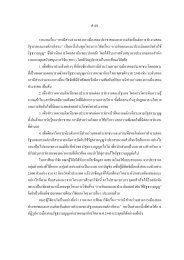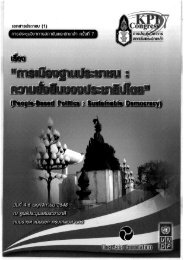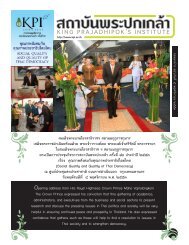SUFFiciENcy EcONOMy ANd GRASSROOtS DEvElOPMENt
SUFFiciENcy EcONOMy ANd GRASSROOtS DEvElOPMENt
SUFFiciENcy EcONOMy ANd GRASSROOtS DEvElOPMENt
Create successful ePaper yourself
Turn your PDF publications into a flip-book with our unique Google optimized e-Paper software.
268<br />
The Payback Period is 8.5 years through proposed tariff as opposed to around 9.5 years through simple<br />
additive<br />
The Meaning<br />
of<br />
of<br />
individual<br />
Sufficiency Economy<br />
tariffs<br />
<br />
as shown in Figure X. The Simple Additive Combination represents<br />
International Conference<br />
individual power plants of having the same capacities as that in bundled solution. The electricity is sold at<br />
a fixed rate of Rs. 9/kWh (Proposed Tariff) in the Bundled Hybrid, but in the Simple Additive<br />
Combination, the electricity is sold at the price of the individual tariffs – as if the electricity from Solar<br />
PV, Wind and Biomass has been produced and sold independently of each other, whereas the same<br />
amount of electricity produced and sold in an integrated power plant bundling these technologies<br />
together.<br />
Figure X: Simulation of Payback Analyses: Bundled Local Hybrid Solution vs.<br />
Simple Combination of the Solutions of same capacities<br />
Figure X: Simulation of Payback Analyses: Bundled Local Hybrid Solution vs. Simple Combination of<br />
the Solutions of same capacities<br />
Hence, our payback analyses simulation shows that it is much more<br />
advantageous to the community level power generation by bundling optimal<br />
combination in proportion to the availability of the local bio-resources. This also<br />
Hence, our payback analyses simulation shows that it is much more advantageous to the community level<br />
ensures that no single resource is overstrained or solely depended upon. The most<br />
power generation by bundling optimal combination in proportion to the availability of the local bioresources.<br />
attractive This utilities also ensures tend that to be no significantly single resource smaller is overstrained than or the solely largest depended utility. upon. (Denholm The most<br />
attractive et al 2009) utilities – the tend case to be for significantly local (distributed) smaller than the power largest generation. utility. (Denholm This et al also 2009) proves – the case in<br />
for local (distributed) power generation. This also proves in favor of small hybrid solutions of alternative<br />
favor of small hybrid solutions of alternative energy.<br />
energy.<br />
Fixed Cost Analysis to compare solutions is also presented in the Table VII.<br />
Table VII: Fixed Cost Analysis according to Simulation Results<br />
Fixed Cost Analysis to compare solutions is also presented in the Table VII.<br />
Solution<br />
Total Fixed Cost (million INR)<br />
Solar 3.91<br />
Wind 1.55<br />
Biomass 0.18<br />
Hybrid 1.91<br />
Table VII: Fixed Cost Analysis according to Simulation Results<br />
Renewable energy technologies that are, by their very nature, intermittent would incur fuel costs to the<br />
extent that backup capacity was used in order to maintain the desired supply of peaking power to the grid.<br />
At low levels of renewable penetration additional system costs would be negligible compared with<br />
generation costs, since variability would still be within normal tolerance levels for the system as a whole.<br />
Thereafter, higher levels of penetration will involve additional cost, since additional generation or<br />
electricity storage capacity would be required to meet peak demand if, for example, wind were<br />
unavailable. As a consequence, at a purely financial level, the value of intermittent generation should be<br />
less than that of conventional generation by approximately these additional costs. Both coal and gas



